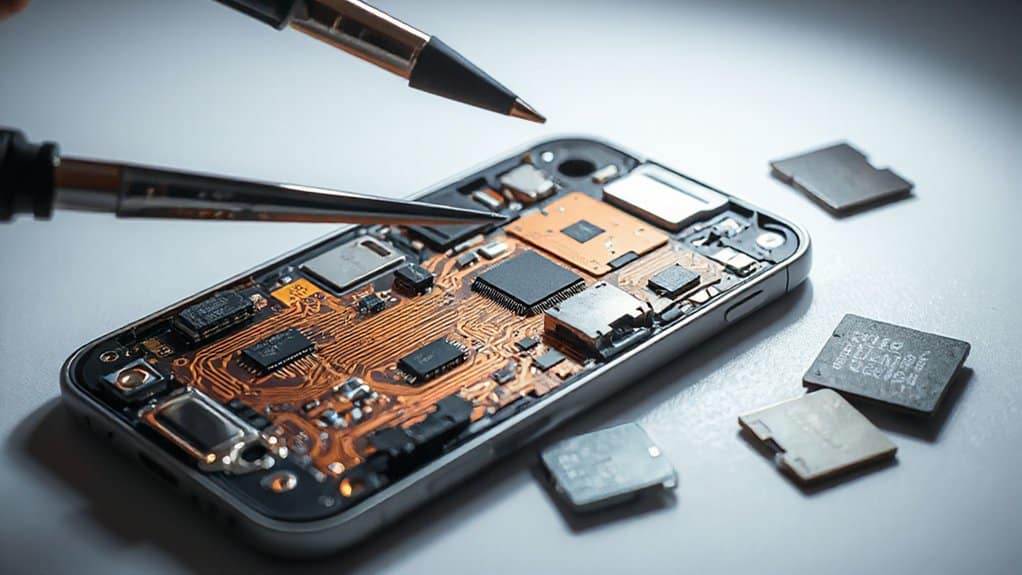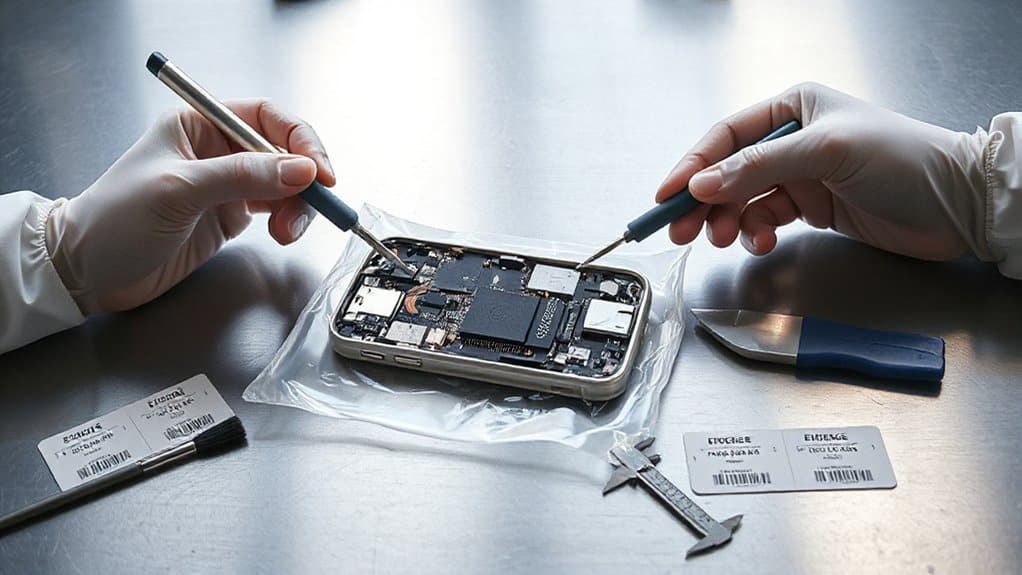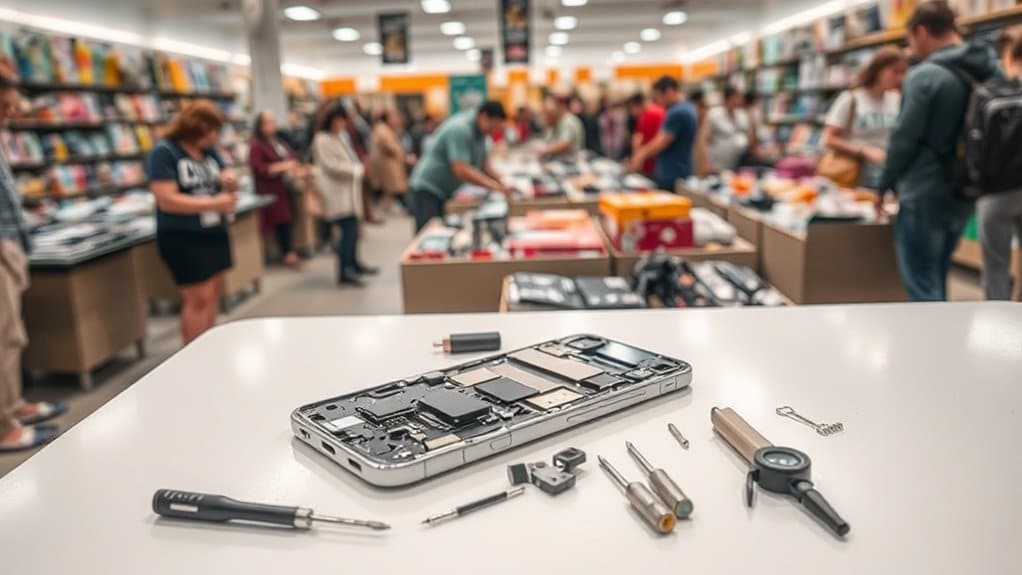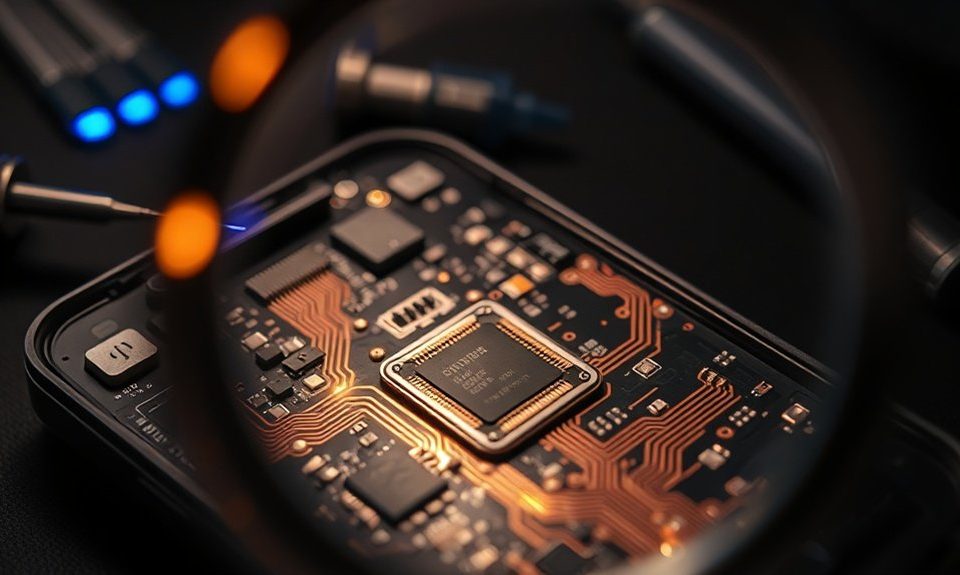Mobile device forensics extracts extensive digital evidence from smartphones and tablets, revealing communication records, location histories, app usage patterns, and media files with timestamps. Investigators utilize industry-standard tools like Cellebrite UFED and XRY Mobile Forensics, employing physical and logical extraction methods to recover both accessible and deleted data. Legal frameworks require proper chain of custody protocols and search warrants for admissible evidence. Modern challenges include encryption barriers, cloud data synchronization, and jurisdiction complexities that demand specialized techniques and adaptive methodologies for complete digital footprint reconstruction.
Key Takeaways
- Mobile forensics extracts comprehensive digital footprints including communication records, location histories, app activity, and media files with timestamps.
- Industry-standard tools like Cellebrite UFED use physical and logical extraction methods to recover both accessible and deleted data.
- Legal frameworks require proper search warrants, chain of custody documentation, and secure evidence storage to ensure admissibility.
- Cloud synchronization across platforms like Google Drive and iCloud creates additional evidence sources but presents encryption and jurisdiction challenges.
- Future trends include increased encryption complexity, ephemeral messaging, and device fragmentation requiring adaptive forensic methodologies and protocols.
What Mobile Device Forensics Reveals About Digital Evidence

When investigators extract data from smartphones, tablets, and other mobile devices, they uncover a thorough digital footprint that extends far beyond traditional computing forensics. Mobile forensics specialists analyze communication patterns, location histories, and app activity to reconstruct user behavior with unprecedented detail. These devices store cached data, deleted messages, call logs, and metadata that reveal connections between individuals and events.
The forensic process examines browser histories, social media interactions, financial transactions, and multimedia files. Investigators leverage specialized tools to recover data from encrypted storage, SIM cards, and cloud synchronization services. Each extraction provides timestamped evidence that establishes digital timelines and user movements. This extensive analysis transforms mobile devices into powerful investigative resources, offering law enforcement and legal professionals detailed insights into suspect activities and digital relationships. Additionally, computer forensics emphasizes the critical need for preserving digital evidence to ensure its integrity during investigations.
Common Types of Data Extracted From Smartphones and Tablets
Digital forensic examinations of smartphones and tablets yield several distinct categories of recoverable data, each providing unique investigative value. Professional investigators systematically extract information that reveals detailed user behavior patterns and digital footprints.
The primary data categories include:
- Communication records – Call logs, message contents, and contact lists documenting interpersonal connections
- Application intelligence – App usage patterns, app data, and social media activity revealing behavioral insights
- Location intelligence – GPS coordinates, location history, and geofenced movements establishing temporal presence
- Media artifacts – Photos, videos, and photo metadata containing embedded timestamps and geographical markers
- Web activity – Browser history, cached pages, and downloaded files tracking online engagement
System files provide additional forensic context, enabling investigators to reconstruct detailed timelines and establish digital evidence chains that support investigative objectives within legal frameworks. Cellphone forensics experts possess the knowledge to navigate intricate data storage methods and encryption technologies, ensuring accurate recovery and analysis of this vital information.
Essential Tools and Software for Mobile Forensic Investigations
Mobile forensic investigations require specialized software solutions capable of bypassing security mechanisms, extracting data thoroughly, and preserving digital evidence integrity. Professional investigators rely on industry-standard platforms like Cellebrite UFED, Oxygen Detective Suite, and XRY Mobile Forensics to perform all-encompassing device examinations. These tools employ various extraction techniques, including physical, logical, and file system approaches, each offering different levels of data access depending on device security configurations.
Investigators must maintain current software updates to address evolving mobile operating systems and security protocols. Open-source alternatives like ALEAPP and iLEAPP provide valuable supplementary analysis capabilities for specific data types. Hardware solutions, including Faraday bags and write blockers, guarantee evidence isolation and prevent remote wiping. Successfully combining these tools requires extensive training and certification to maintain forensic standards within the investigative community.
Legal Considerations and Chain of Custody Requirements

Although technical expertise enables successful data extraction from mobile devices, forensic investigators must navigate complex legal frameworks that govern evidence admissibility and procedural compliance. These regulations protect constitutional rights while maintaining investigative integrity.
Professional investigators implement rigorous chain of custody protocols to preserve evidence validity:
- Documentation Requirements – Record every person handling evidence with timestamps and purpose
- Search Warrant Specifications – Obtain proper authorization addressing specific devices and data types
- Privacy Concerns Mitigation – Balance investigative needs with Fourth Amendment protections
- Evidence Integrity Verification – Use cryptographic hashes to prove data remains unaltered
- Storage Security Standards – Maintain physical and digital evidence in controlled, auditable environments
Understanding legal frameworks guarantees forensic practitioners deliver courtroom-ready evidence while respecting individual privacy rights and procedural safeguards. Furthermore, the ability to recover deleted data can significantly strengthen a case by providing critical evidence that would otherwise be lost.
Overcoming Encryption and Security Barriers in Modern Devices
Beyond establishing proper legal protocols, forensic investigators encounter substantial technical obstacles when modern mobile devices deploy sophisticated encryption schemes and multi-layered security architectures. Contemporary smartphones implement Advanced Encryption Standard (AES) 256-bit encryption, hardware security modules, and secure enclaves that create formidable barriers to data extraction. Professional forensic teams employ specialized techniques including chip-off methods, JTAG interfaces, and ISP connections to bypass conventional access restrictions. Commercial forensic platforms like Cellebrite UFED and Oxygen Detective Suite provide investigators with automated solutions for circumventing common security protocols. However, zero-day exploits and vendor-specific vulnerabilities remain essential resources for accessing locked devices. Investigators must continuously adapt methodologies as manufacturers strengthen encryption methods through regular security updates, creating an ongoing technological arms race between forensic capabilities and device protection mechanisms. This dynamic landscape poses significant challenges for computer forensics investigators, who must stay informed about evolving technologies to maintain data integrity.
Physical vs. Logical Extraction Methods Explained
Two primary extraction methodologies define the strategic approach forensic investigators employ when acquiring data from mobile devices: physical extraction and logical extraction. Each technique serves distinct investigative purposes within the digital forensics community.
Physical extraction creates bit-for-bit copies of device memory, including deleted data and system files. This methodology provides extensive access to raw device storage, enabling recovery of previously inaccessible information. Logical extraction retrieves only accessible data through standard device interfaces, respecting system-level restrictions and user permissions.
Key distinctions between methodologies include:
- Data completeness: Physical extraction captures entire storage versus accessible files only
- Technical complexity: Physical methods require specialized hardware and advanced expertise
- Time requirements: Physical processes typically demand considerably longer acquisition periods
- Legal admissibility: Both approaches maintain chain-of-custody standards when properly documented
- Device compatibility: Logical extraction offers broader device support across manufacturers
- Consideration of evolving technology: Investigators must adapt to emerging forensic technologies that continually shape the methodology landscape.
Cloud Data Integration and Remote Evidence Collection

Modern mobile devices seamlessly synchronize with cloud storage platforms, creating distributed evidence repositories that extend far beyond physical device boundaries. Forensic investigators must now navigate complex multi-platform ecosystems where critical evidence resides across Google Drive, iCloud, OneDrive, and specialized application servers.
Cloud extraction techniques require specialized tools and legal frameworks to access remotely stored data. Investigators employ API-based methods, service provider cooperation, and warrant-backed requests to retrieve synchronized photographs, messages, documents, and application data. This evidence recovery process demands understanding of data synchronization patterns, retention policies, and geographic storage locations. Additionally, the importance of utilizing state-of-the-art technology cannot be understated to effectively manage the intricacies of cloud forensics.
Remote evidence collection presents unique challenges including data encryption, jurisdiction boundaries, and real-time synchronization conflicts. Successful cloud forensics requires coordinated approaches combining traditional device analysis with thorough cloud service investigation, ensuring complete digital footprint reconstruction.
Real-World Case Studies in Mobile Forensics
Practical implementation of cloud data integration and remote evidence collection methodologies becomes evident through documented forensic investigations that demonstrate both successful techniques and procedural limitations.
Comprehensive analysis of landmark investigations reveals critical patterns that shape contemporary mobile forensics protocols. These documented case outcomes provide our forensic community with essential benchmarks for methodology refinement and procedural standardization.
Key forensic insights from documented investigations include:
- Encrypted messaging applications requiring specialized bypass techniques for data extraction
- Geolocation metadata correlation across multiple cloud platforms proving suspect movement patterns
- Social media authentication challenges when establishing digital identity verification
- Cross-border jurisdiction complications affecting evidence admissibility in international prosecutions
- Timeline reconstruction methodologies using combined device logs and cloud synchronization records
These real-world applications demonstrate how theoretical frameworks translate into practical investigative success, providing our professional community with proven methodologies for complex digital evidence scenarios. Furthermore, the evolving landscape of drone technology necessitates an ongoing adaptation of forensic strategies to address new challenges in digital investigations.
Future Trends and Emerging Challenges in Cell Phone Analysis
As technological evolution accelerates at an unprecedented pace, forensic analysts face increasingly complex challenges that threaten to outpace traditional investigative methodologies. Device fragmentation across multiple operating systems and hardware configurations creates inconsistent extraction protocols, while data volatility increases as applications implement ephemeral messaging and automatic deletion features.
AI advancements introduce sophisticated encryption methods that challenge current decryption capabilities, simultaneously offering new analytical tools for real time analysis. Privacy concerns drive manufacturers to implement stronger security measures, creating tension between user protection and investigative access. Emerging technologies like quantum computing and blockchain present novel evidence types requiring specialized expertise.
Cross jurisdictional issues complicate international investigations, while ethical dilemmas arise regarding surveillance boundaries and data ownership. These converging challenges demand adaptive methodologies and collaborative frameworks to maintain forensic integrity.
Frequently Asked Questions
How Long Does a Typical Mobile Device Forensic Examination Take to Complete?
Examination timeline varies considerably based on multiple analysis factors affecting forensic procedures. Simple extractions typically require several hours, while extensive examinations span days or weeks. Critical analysis factors include device encryption strength, data volume, hardware complexity, and investigative scope requirements. Specialized forensic professionals systematically process evidence using standardized methodologies, ensuring thorough documentation throughout each phase. Timeline estimation depends on case-specific variables, available resources, and technical challenges encountered during systematic digital evidence recovery and validation procedures.
What Qualifications or Certifications Do Mobile Forensics Examiners Need to Have?
Mobile forensics examiners require thorough certification requirements encompassing both technical and legal competencies. Industry-standard certifications include CCE (Certified Computer Examiner), GCFA (GIAC Certified Forensic Analyst), and vendor-specific credentials from Cellebrite or Oxygen. Rigorous forensic training programs emphasize evidence preservation, chain of custody protocols, and court testimony procedures. Practitioners must maintain continuing education units to preserve certification validity. Professional organizations provide structured pathways ensuring examiners possess requisite skills for methodical digital evidence extraction and analysis procedures.
Can Deleted Data From a Water-Damaged Phone Still Be Recovered Successfully?
Deleted data recovery from water-damaged devices remains feasible through specialized methodical approaches. Professional examiners employ controlled drying techniques, component-level repairs, and chip-off extraction methods when standard interfaces fail. Water damage recovery success depends on contamination type, exposure duration, and immediate response protocols. Forensic practitioners utilize cleanroom environments and precision tools to access storage chips directly. While challenging, systematic water damage recovery procedures enable successful deleted data recovery in many cases through proven technical methodologies.
How Much Does Professional Mobile Device Forensic Analysis Typically Cost?
Professional mobile device forensic analysis costs vary considerably based on several cost factors including device complexity, data volume, and urgency requirements. Basic examinations typically range from $500-$1,500, while thorough analyses can exceed $5,000. Law enforcement agencies and certified laboratories often provide more affordable options through standardized pricing structures. Factors such as encryption levels, physical damage, and specialized recovery techniques directly influence final pricing. Many practitioners offer tiered service packages to accommodate different investigative budgets and requirements.
What Should I Do Immediately After My Phone Is Stolen or Lost?
When discovering device theft or loss, one must immediately initiate systematic protective measures. Priority actions include reporting theft to law enforcement and service providers to establish official documentation. Simultaneously, activating remote locking capabilities through manufacturer security services prevents unauthorized access to sensitive data. Change all account passwords associated with the device, monitor financial accounts for suspicious activity, and document the incident timeline with specific details for investigative purposes and insurance claims.
Conclusion
Mobile device forensics continues evolving as smartphones become increasingly sophisticated repositories of digital evidence. Practitioners must navigate complex technical challenges including advanced encryption protocols, diverse operating systems, and cloud-based data storage architectures. Successful investigations require systematic application of appropriate extraction methodologies, adherence to legal frameworks, and utilization of specialized forensic tools. As mobile technology advances, forensic professionals must continuously adapt their techniques to effectively recover, analyze, and present digital evidence while maintaining investigative integrity.







